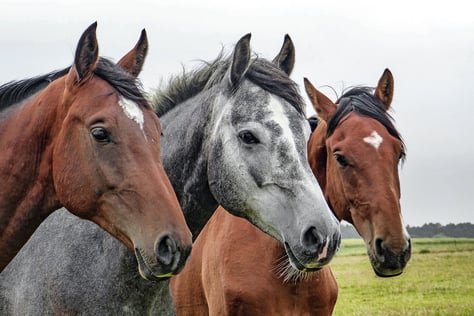Horses are both heterodontous and diphyodontous, which means that they have teeth in more than one shape (there are up to five shapes of tooth in a horse’s mouth), and have two successive sets of teeth, the deciduous (“baby teeth”) and permanent sets.
 By the time a horse is fully developed, usually at around five years of age, it will have between 36 and 44 teeth – mares have 40 permanent teeth and males have 42 permanent teeth. The difference is that males have 2 canine teeth that the female does not have. All horses have twelve incisors at the front of the mouth, used primarily for cutting food, most often grass, whilst grazing. They are also used as part of a horse’s attack or defense against predators, or as part of establishing social hierarchy within the herd. Behind the front incisors is the interdental space, where no teeth grow from the gums. This is where the bit rests when horses are ridden or driven. Behind the interdental space, all horses have twelve premolars and twelve molars, also known as cheek teeth or jaw teeth. These teeth chew food bitten off by incisors, prior to swallowing.
By the time a horse is fully developed, usually at around five years of age, it will have between 36 and 44 teeth – mares have 40 permanent teeth and males have 42 permanent teeth. The difference is that males have 2 canine teeth that the female does not have. All horses have twelve incisors at the front of the mouth, used primarily for cutting food, most often grass, whilst grazing. They are also used as part of a horse’s attack or defense against predators, or as part of establishing social hierarchy within the herd. Behind the front incisors is the interdental space, where no teeth grow from the gums. This is where the bit rests when horses are ridden or driven. Behind the interdental space, all horses have twelve premolars and twelve molars, also known as cheek teeth or jaw teeth. These teeth chew food bitten off by incisors, prior to swallowing.
The first four or five years of a horse’s life are when the most growth-related changes occur and frequent checkups may prevent problems from developing. Equine teeth get harder as the horse gets older. Rapid changes occur during the prime adult years of life, but as a horse ages, particularly from the late teens on, additional changes in incisor angle and other molar growth patterns often necessitate frequent dental care. Good dental care can help your horse lead a longer, healthier life.



